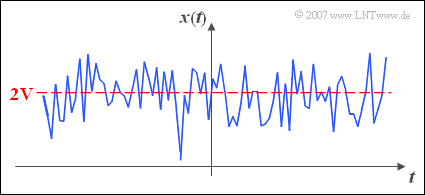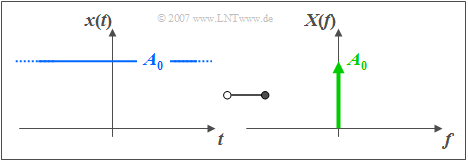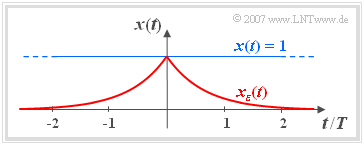Contents
Time Signal Representation
$\text{Definition:}$ A direct current (DC) signal is a deterministic signal whose instantaneous values are constant for all times $t$ from $-\infty$ to $+\infty$ . Such a signal is the boundary case of a harmonic oscillation, where the period duration $T_{0}$ has an infinitely large value.
According to this definition a DC signal always ranges from $t = -\infty$ to $t = +\infty$. If the signal is only switched on at the time $t = 0$ there is no DC signal.
- A direct signal can never be a carrier of information in the message-technical sense, but message signals can possess a direct signal part .
- All statements made in the following for the direct current signal apply in the same way also to such a direct signal component.
$\text{Definition:}$ For the DC signal component $A_{0}$ of any signal $x(t)$ applies:
- $$A_0 = \lim_{T_{\rm M}\to\infty}\,\frac{1}{T_{\rm M} }\cdot\int^{T_{\rm M}/2}_{-T_{\rm M}/2}x(t)\,{\rm d} t. $$
- The measurement duration $T_{\rm M}$ should always be selected as large as possible (infinite in borderline cases).
- The given equation is only valid if $T_{\rm M}$ symmetrical about the time $t=0$ lies.
$\text{Example 1:}$ The graph shows a stochastic signal $x(t)$.
- The DC component $A_{0}$ is here $2\ \rm V$.
- In the sense of statistics, $A_{0}$ corresponds to the linear mean value.
Spectral Representation
We now look at the situation in the frequency domain. From the time function it is already obvious, that it contains - spectrally speaking - only one single (physical) frequency, namely the frequency $f=0$.
This result shall now be derived mathematically. In anticipation of the chapter Fouriertransformation the connection between the time signal $x(t)$ and the corresponding spectrum $X(f)$ is already given here:
- $$X(f)= \hspace{0.05cm}\int_{-\infty} ^{{+}\infty} x(t) \, \cdot \, { \rm e}^{-\rm j 2\pi \it ft} \,{\rm d}t.$$
The spectral function $X(f)$ after the French mathematician Jean Baptiste Joseph Fourier is called the Fourier transform of $x(t)$ and the short name for this functional relation is
- $$X(f)\ \bullet\!\!-\!\!\!-\!\!\circ\,\ x(t).$$
For example, if $x(t)$ describes a voltage curve, so $X(f)$ has the unit "V/Hz
Applying this transformation equation to the DC signal $x(t)=A_{0}$ yields the spectral function
- $$X(f)= A_0 \cdot \int_{-\infty} ^{+\hspace{0.01cm}\infty}\rm e \it ^{-\rm {j 2\pi} \it ft} \,{\rm d}t.$$
with the following properties:
- The integral diverges for $f=0$, i.e. it returns an infinitely large value (integration over the constant value 1)
- For a frequency $f\ne 0$ on the other hand, the integral is zero; the corresponding proof, however, is not trivial (see next page).
$\text{Definition:}$ The searched spectral function $X(f)$ is compactly expressed by the following equation
- $$X(f) = A_0 \, \cdot \, \rm \delta(\it f).$$
- $\delta(f)$ is denoted as the '’'Dirac function, also known as "distribution".
- $\delta(f)$ is a mathematically complicated function; the derivation can be found on the next page.
$\text{Example 2:}$ The graphic shows the functional connection
- between an DC signal $x(t)=A_{0}$ and
- its corresponding spectral function $X(f)=A_{0} \cdot \delta(f)$.
The Dirac function at frequency $f=0$ is represented by an arrow with the weight $A_{0}$
Dirac Function in Frequency Domain
$\text{Definition:}$ Die für die funktionale Beschreibung von nachrichtentechnischen Systemen äußerst wichtige Diracfunktion weist folgende Eigenschaften auf:
- Die Diracfunktion ist unendlich schmal, das heißt, es ist $\delta(f)=0$ für $f \neq 0$.
- Die Diracfunktion $\delta(f)$ ist bei der Frequenz $f = 0$ unendlich hoch.
- Die Impulsfläche der Diracfunktion ergibt einen endlichen Wert, nämlich $1$:
- $$\int_\limits{-\infty} ^{+\infty} \delta( f)\,{\rm d}f =1.$$
- Aus dieser letzten Eigenschaft folgt, dass $\delta(f)$ die Einheit ${\rm Hz}^{-1} = {\rm s}$ besitzt.
$\text{Proof:}$ Zur mathematischen Herleitung obiger Eigenschaften gehen wir von einem dimensionslosen Gleichsignal aus.
Um die Konvergenz des Fourierintegrals zu erzwingen, wird das nicht energiebegrenzte Signal $x(t)$ mit einer beidseitig abfallenden Exponentialfunktion multipliziert. Die Grafik zeigt das Signal $x(t)=1$ und das energiebegrenzte Signal
- $$x_{\varepsilon} (t) = \rm e^{\it -\varepsilon \hspace{0.05cm} \cdot \hspace{0.05cm} \vert \hspace{0.01cm} t \hspace{0.01cm}\vert}{.}$$
Hierbei gelte $\varepsilon > 0$. Im Grenzübergang $\varepsilon \to 0$ geht $x_{\varepsilon}(t)$ in $x(t)=1$ über.
Zur Spektraldarstellung kommt man durch Anwendung des vorne angegebenen Fourierintegrals:
- $$X_\varepsilon (f)=\int_{-\infty}^{0} {\rm e}^{\varepsilon{t} }\, {\cdot}\, {\rm e}^{-\rm j 2\pi \it ft} \,{\rm d}t \hspace{0.2cm}+ \hspace{0.2cm} \int_{0}^{+\infty} {\rm e}^{-\varepsilon t} \,{\cdot}\, { \rm e}^{-\rm j 2\pi \it ft} \,{\rm d}t.$$
Nach Integration und Zusammenfassen beider Anteile erhalten wir die rein reelle Spektralfunktion des energiebegrenzten Signals $x_{\varepsilon}(t)$:
- $$X_\varepsilon (f)=\frac{1}{\varepsilon -\rm j \cdot 2\pi \it f} + \frac{1}{\varepsilon+\rm j \cdot 2\pi \it f} = \frac{2\varepsilon}{\varepsilon^2 + (\rm 2\pi {\it f}\hspace{0.05cm} ) \rm ^2} \, .$$
Die Fläche unter der $X_\varepsilon (f)$–Kurve ist unabhängig vom Parameter $\varepsilon$ gleich $1$. Je kleiner $ε$ gewählt wird, um so schmaler und höher wird die Funktion, wie das Lernvideo Herleitung und Visualisierung der Diracfunktion zeigt.
Der Grenzübergang für $\varepsilon \to 0$ liefert die Diracfunktion mit dem Gewicht $1$:
- $$\lim_{\varepsilon \hspace{0.05cm} \to \hspace{0.05cm} 0}X_\varepsilon (f)= \delta(f).$$
Exercises for the chapter
Aufgabe 2.2: Gleichsignalanteile
Aufgabe 2.2Z: Nichtlinearitäten



